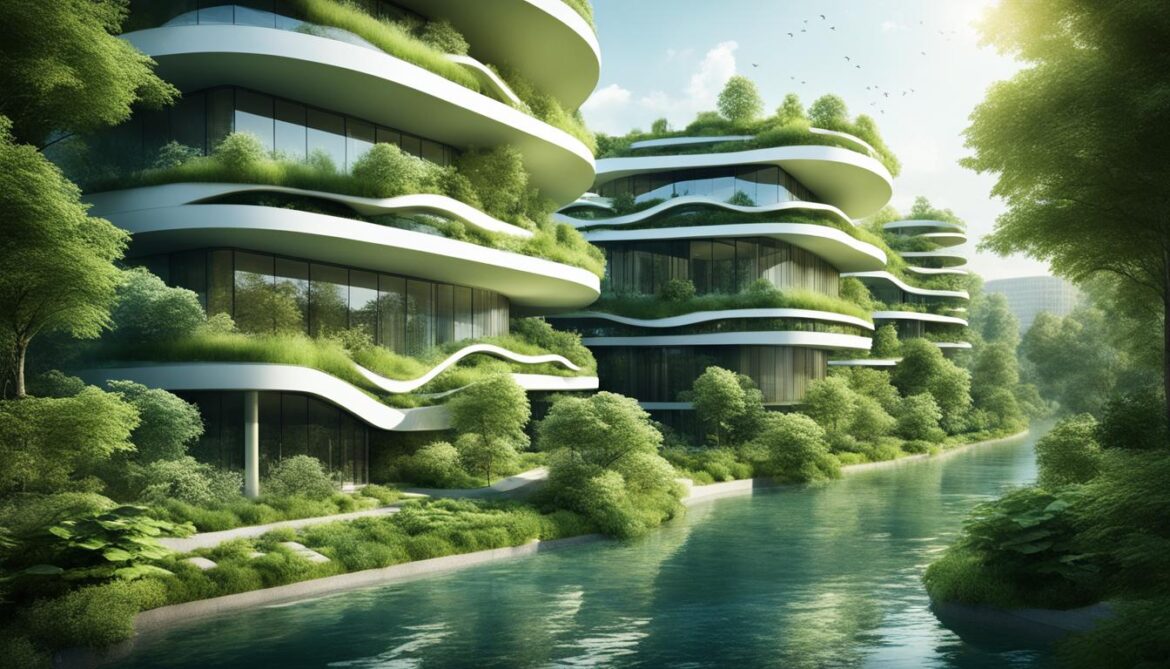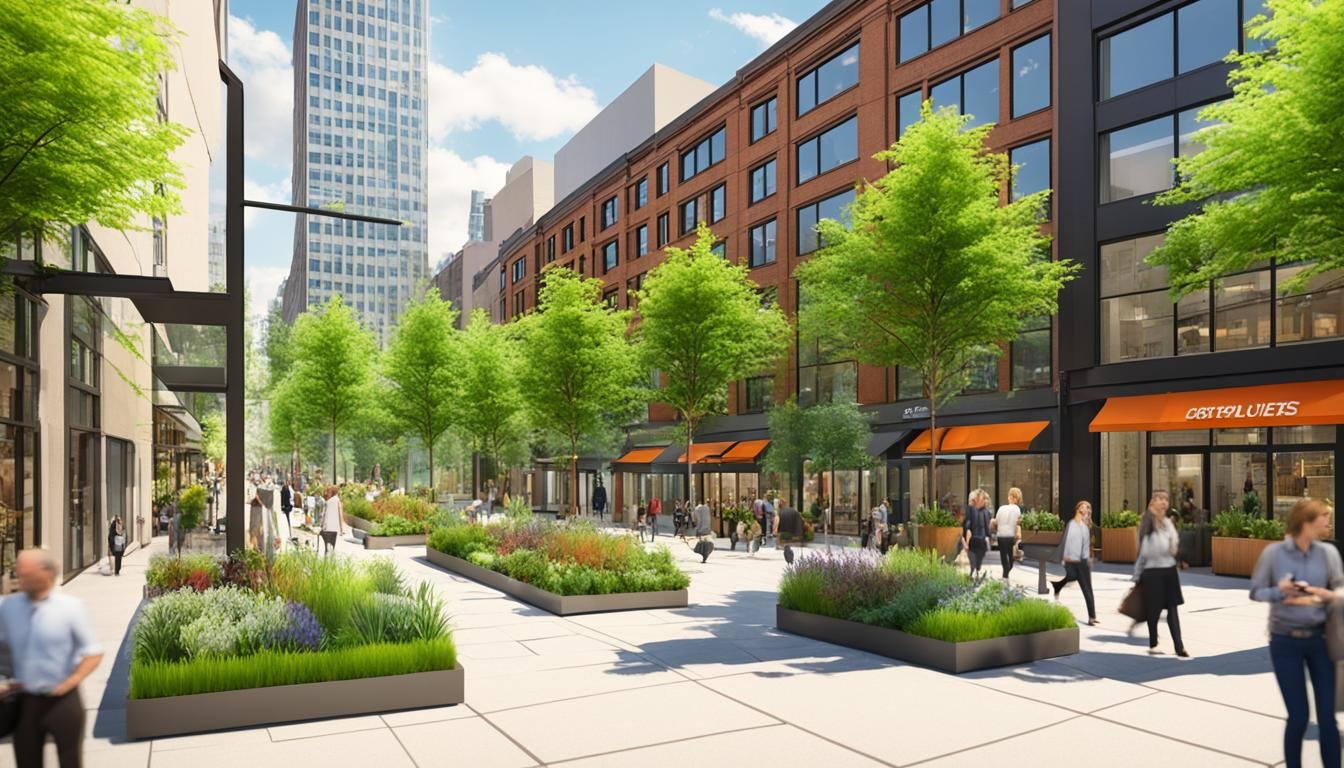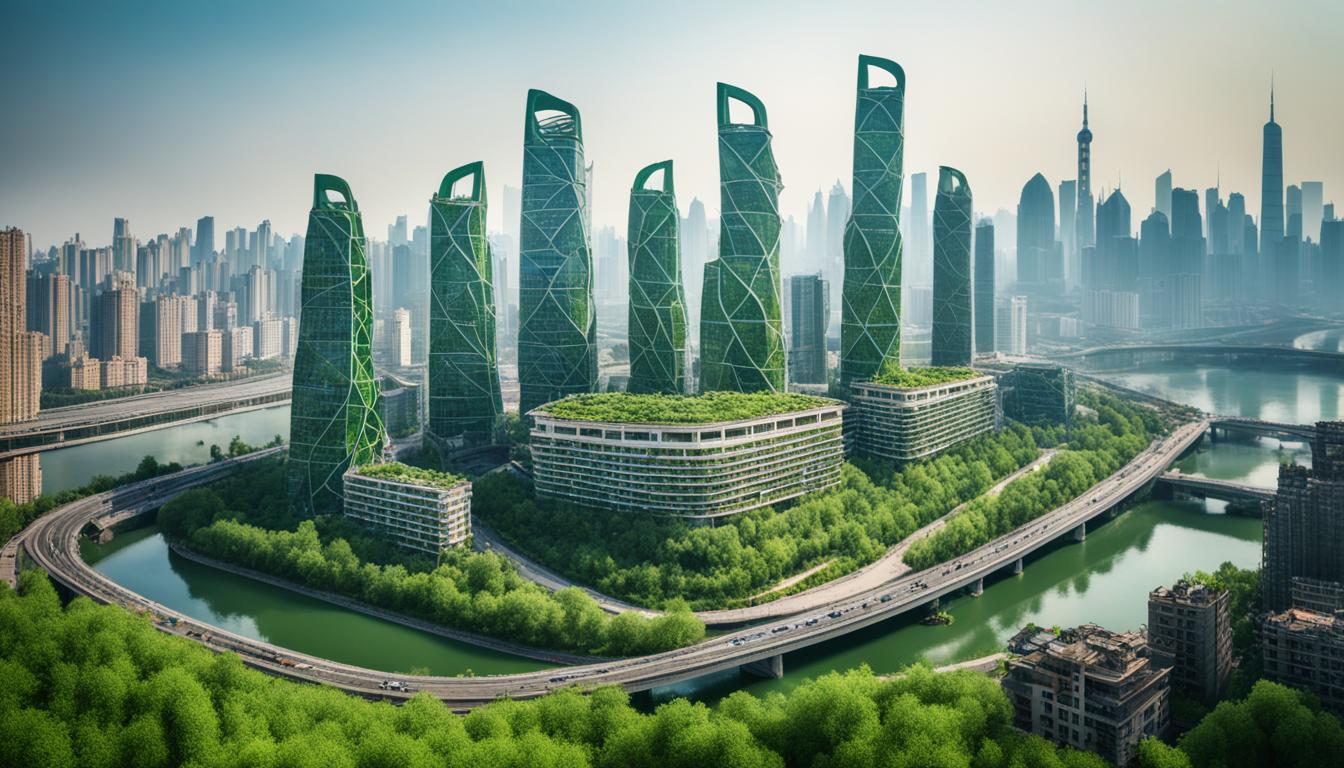Living Buildings: Integrating Natural Habitats into Architectural Design
Did you know, over 40% of global greenhouse gas emissions come from buildings? This highlights the urgent need to change how we build. ‘Living buildings’ seamlessly blend biophilic architecture, sustainable design, and green infrastructure. They create a balance between nature and our constructions.
Such an approach is more than sustainable building. It aims to boost urban biodiversity and connect people with nature. Following the Living Building Challenge, creators are achieving amazing things. They make buildings that create energy, recycle water, and function at their best, all while looking beautiful.
These buildings vary—from renovations to new projects. They all pick a Living Transect category, like natural habitat preserves or urban core zones. This choice ensures the design meets the site’s specific needs and fits the local environment.
Key Takeaways
- Living buildings integrate natural habitats and sustainable design principles to achieve a balance between the built and natural environments.
- The Living Building Challenge guides the creation of advanced, sustainable structures.
- Living buildings vary in type, designed to fit within a particular ‘Living Transect’ category.
- Biophilic architecture and nature-inspired design aim to enhance urban biodiversity and deepen the bond between people and nature.
- Key features of living buildings include generating renewable energy, conserving water, and operating efficiently.
Introduction to Living Buildings
Usually, buildings were made without much thought for nature. They focused on function, comfort, and cost only. But, things are changing. Now, with the rise of sustainable design, buildings aim to be friendly to the earth too. This new approach promotes the creation of structures that work well with, and even improve, their environment.
One key idea behind this is to see buildings as part of a bigger ecosystem. This view has given birth to new kinds of buildings. They are based on the ideas of living, regenerative, restorative and adaptive buildings. These are built with strategies and technologies that do more than look nice. They actually help nature by using less energy and cutting down on waste.

For example, living buildings fit into their surroundings without harming them. They use renewable energy, save water, and include nature in their design. This way, they try to give back to nature as much as they take.
This approach marks a big shift in how we think about buildings. It aims for a future where buildings and nature support each other. So, they make the world a better place for all to live in.
| Feature | Traditional Buildings | Living Buildings |
|---|---|---|
| Energy Source | Reliance on grid-supplied electricity and fossil fuels | Renewable energy generation, such as solar, wind, and geothermal |
| Water Management | Dependence on municipal water supply and wastewater treatment | Onsite water harvesting, treatment, and recycling for net-positive water impact |
| Environmental Impact | Disregard for natural habitats and ecosystems | Integration with and restoration of natural environments |
| Building Autonomy | Reliance on external infrastructure and utility systems | Self-sustaining and autonomous operation |
The Principles of Living Buildings
Living buildings is a new way to think about architecture. It’s all about making buildings that work perfectly with nature. These buildings live on their own, without needing the usual power or water sources. Or they work to give back as much as they take, by using renewable energy and materials.
Sustainable Design Elements
For a building to truly live, it must act like nature. It should use things like rain, wind, and sunlight for its needs. This way, the building doesn’t harm the environment but becomes part of it instead.
The Seven Petals of Living Buildings
The Living Building Challenge (LBC) sets the bar high for green building standards. It guides designers and builders with seven important principles. These ideas help make sure buildings are eco-friendly, good for people, and blend well with nature.

Benefits of Living Buildings
Living buildings offer many advantages across environmental, economic, and social areas. By using sustainable design and natural habitats, they make life better for everyone. This includes both people and our planet.
Environmental Benefits
Living buildings help improve and protect biodiversity and ecosystems. They also enhance air and water quality and reduce waste streams. They aim to preserve and restore natural resources, which keeps the environment healthier. This lessens their impact on nature around them.
Economic Benefits
There are economic benefits from living buildings too. They can lower operating costs by using resources wisely. Also, they help create, expand, and shape markets for green products and services.
These buildings make people working inside more productive. They also have a positive effect on long-term financial benefits.
Social Benefits
Living buildings also bring social advantages to the people in and around them. They make living and working areas more comfortable and healthy. The surroundings become more beautiful while putting less pressure on local services. This makes life better for everyone nearby.

The best of these buildings stand out as leaders in sustainability. They set a great example for others and help build a sustainable future.
Challenges in Creating Living Buildings
Creating Challenges of Living Buildings can be tough for those wanting to build net-zero energy buildings. The High Costs of Living Buildings are often named as a big issue. This high cost comes from using renewable energy, meeting strict green standards, and building to allow life itself to thrive.
Finding Sustainable Building Materials is also a big challenge. Many building materials are not good for the environment or health. Using locally sourced materials can help lower the impact on nature.
But, as more green technologies are used, the cost of living buildings is expected to go down. This movement towards greener construction promises a better future. It will make living buildings an option for more projects.

Living Buildings and Biophilic Design
Ecological architecture blends sustainable principles with building design. Its goal is to make buildings work well with nature. This includes reducing harm to the environment and aiming for a greener path forward. It focuses on using less energy, cutting carbon emissions, and making spaces that nature loves.
Connecting with Nature
Biophilic Architecture finds a balance between buildings and nature. Architects use it to fit buildings naturally into their settings. This way, trees, water, and wildlife stay protected. It’s a design approach called Biophilic Design. It’s about connecting people with nature by bringing the outdoors inside the built areas.
Integrating Natural Habitats into Architectural Design
Integrating Natural Habitats into building design brings people closer to nature. Architects make spaces like green roofs and gardens. They also work to keep natural lands safe. This adds benefits to human health and the environment. Such designs not only help people but also the local plants and animals.

Materials and Construction Techniques
Sustainable building is key in protecting our earth. It helps keep the environment safe while making sure buildings fit well with nature. The choice of sustainable building materials and non-toxic options is critical. They make indoor spaces healthier.
Sustainable and Non-Toxic Materials
Architects look for non-toxic materials in paints, floors, and insulation. They prefer low VOC paints, natural flooring, and green insulation. These choices make the air inside better. They also support the goals of sustainable architecture.
Locally Sourced and Recycled Materials
Locally sourced materials are vital in green building. This means using materials found nearby. It saves on the energy needed for transport and cuts down on pollution. Items like reclaimed wood, natural stone, earth walls, and bamboo are common. They not only help the planet but also add a beautiful, natural look to buildings.

Energy Efficiency in Living Buildings
Energy efficiency is key in making buildings green. It focuses on using less energy from usual sources. With passive design principles like the right layout, letting in fresh air, and using good insulation, architects keep indoor temperatures nice. They can do this without needing a lot of heating or cooling systems.
Renewable Energy Sources
By adding renewable energy sources like solar panels, wind turbines, and geothermal systems, buildings can make their own clean power. New technology and materials mean we’re always getting better at saving energy. Things like net-zero energy buildings and passive house design are pushing how much we can save further.
Passive Design Strategies
Smart building systems and artificial intelligence are also making a difference. They help use energy smarter, making people in the building more comfortable. This approach, called sustainable architecture and green building technologies, leads to homes and offices that use very little energy. It’s setting a great example for future designs that are kind to the environment.
Water Management and Conservation
Living buildings aim to be more than just structures. They capture and treat their own water, making a net-positive water impact. Strategies like rainwater harvesting and water treatment and recycling are key. This means they collect rainwater and treat used water to reuse, reducing their water needs.
Rainwater harvesting uses systems to collect water for various tasks, from building use to watering plants. Meanwhile, water recycling systems clean and reuse water. These efforts lessen the load on city water supplies.
So, using less water not only helps save natural resources, it also eases the pressure on local utilities. By applying special techniques, these buildings give back more water than they take.

Net Positive Water
The idea of net-positive water is crucial for modern buildings. They aim to return more water to nature than they use. To do this, they collect rainwater, recycle water, and treat wastewater.
Water Harvesting and Recycling
Rainwater harvesting is vital for these buildings. They gather and store rain for various uses, cutting water demand. Meanwhile, water recycling systems reuse wastewater. This lessens the need for water from cities.
With these sustainable water practices, living buildings become net water contributors. They give more water back to the planet than they take. This makes them part of ecological architecture that benefits the environment.
Urban Agriculture and Green Spaces
Biodiversity and nature conservation are key for making cities both sustainable and strong. The use of green spaces, like parks, gardens, and green roofs, fights the heat island effect. They also make the air cleaner and give homes to city wildlife.
Rooftop Gardens and Vertical Farms
Rooftop gardens and vertical farms are changing our cities, bringing food into our city landscapes. They cut the need for faraway food sources. They also make cities more varied with plants and animals, boosting biodiversity.
Enhancing Biodiversity
Architects and city planners are focusing on ways to bring more nature into our cities. This helps save and regrow natural areas, making cities better places to live. This effort, called ecological landscaping, is crucial for sustainable urban design.
| Benefits of Urban Agriculture and Green Spaces | Examples |
|---|---|
| Mitigating heat island effect | Parks, gardens, green roofs |
| Improving air quality | Urban forests, green walls |
| Providing habitats for urban wildlife | Pollinator gardens, bird-friendly landscaping |
| Promoting local food production | Rooftop farms, vertical farms, community gardens |
| Enhancing biodiversity | Native plant species, wildlife corridors |
Case Studies of Living Buildings
This part will look at some amazing examples of living buildings. They show how natural habitats and green design can be part of architecture. We’ll see the mighty Bibliotheca of Alexandria and the modern Centre for the Built Environment (CBE) in Nova Scotia, Canada. These places use clever techniques and materials. They work with nature to make buildings that fit beautifully into their surroundings.
The Bibliotheca of Alexandria mixes the building with nature perfectly. It honours the old library with its design. The new part has a big green roof, a light and air-filled atrium, and uses eco-friendly materials.
In Canada, the Centre for the Built Environment (CBE) is a top example of a net-zero building. It got living building certification. It uses smart designs, natural power, and clever water systems. The CBE shows how to make a stunning and green building.
These and other top projects are pushing for better buildings. They offer lessons and show the way in green architecture. By looking at these buildings, architects and designers learn how to make people-friendly and earth-loving structures.
| Project | Location | Design Strategies | Certification |
|---|---|---|---|
| Bibliotheca of Alexandria | Alexandria, Egypt | Biophilic design, locally sourced materials, green roof | Striving for living building certification |
| Centre for the Built Environment (CBE) | Nova Scotia, Canada | Net-zero energy, passive design, renewable energy sources, water management | Living building certified |
These case studies are a lesson in the power of living buildings. They can be good for people and the planet. They set the bar high for future projects in sustainable architecture. These stories light the way to a building future that’s friendly to all.
Future of Living Buildings
The future of living buildings looks bright. Thanks to new tech and materials, we’re raising the bar on saving energy, water, and nature. Smart building systems, artificial intelligence, and innovative materials are at the forefront. They promise to make buildings even greener, aiming for net-zero or net-positive status.
Advancements in Technology
New building technology is key to a greener world. We’re seeing cool stuff like facades that clean themselves and air-purify. Plus, smart systems and AI are changing how we use energy and water. They’re making autonomous buildings closer to reality every day.
Sustainable Urban Planning
Putting living buildings in cities helps make them stronger and greener. By looking at the big picture and adding green spaces and urban farming, we can make structures that do more than just stand. They help the whole area, both nature and people.
Conclusion
The idea of living buildings is changing how we see architectural design. It focuses on blending our built environment with natural habitats. This supports a balanced and peaceful connection between what we build and nature.
Architects and designers use sustainability, energy efficiency, water conservation, and biophilic design. They design buildings that support not only us but also our planet. This way, they help in keeping our ecosystems healthy.
The future of living buildings looks very hopeful. With new technology and materials, we can make our urban landscapes better. They will be more in tune with nature and good for all living things.
By sticking to these smart design strategies, we’re heading to a better tomorrow. A future where our buildings and nature work well together. It’s about living in a way that makes both our world and our environment thrive.
FAQ
What are the key principles of living buildings?
Living buildings are self-sufficient, not needing the electrical grid or other systems. They aim for a net-zero effect on the environment. They work with nature and get their needs from the natural world.
What are the seven petals of the Living Building Challenge?
There are seven petals in the Challenge. These are: place, water, energy, health and happiness, materials, equity, and beauty.
What are the prospective benefits of living buildings?
Living buildings could help save biodiversity and ecosystems. They improve the air and water. Also, they cut waste, save and restore natural resources, and reduce costs. They create markets for green products and make life better for people living and working in them.
What are the main challenges in creating living buildings?
The main hurdles are high costs and reaching net-zero energy. Also, finding materials that are truly sustainable is tough.
How do living buildings integrate with natural habitats and ecosystems?
They mimic natural processes, using resources like rainwater and sunlight. This fosters a connection between the built and natural worlds.
What are the key strategies for achieving energy efficiency in living buildings?
They use passive design and add solar panels and wind turbines. Smart building systems help save energy. Artificial intelligence optimises energy use too.
How do living buildings manage water resources?
They collect and treat their own water, having more water for the environment than they use. This includes rainwater harvesting and water recycling.
How do living buildings incorporate urban agriculture and green spaces?
These buildings have green places like rooftop gardens and vertical farms. They fight the heat island effect and offer homes for urban wildlife.
What are some examples of successful living building case studies?
Key examples are the Bibliotheca of Alexandria and the CBE in Nova Scotia. They show how to blend nature with design in buildings.
What is the future outlook for living buildings?
Living buildings have a bright future with new tech and materials. They’ll improve in energy efficiency, water saving, and nature blending. Smart systems and AI will boost these efforts even more.







